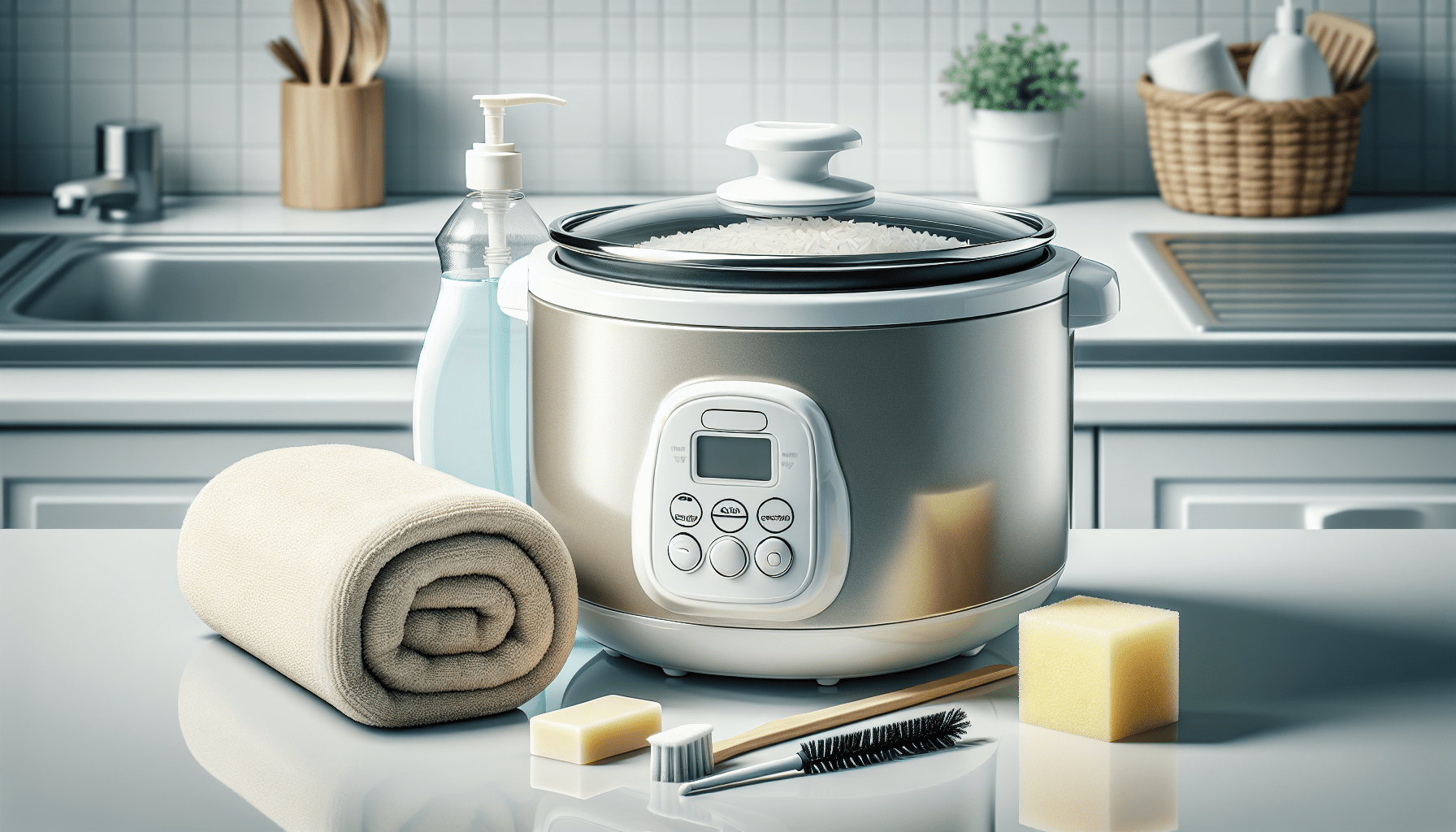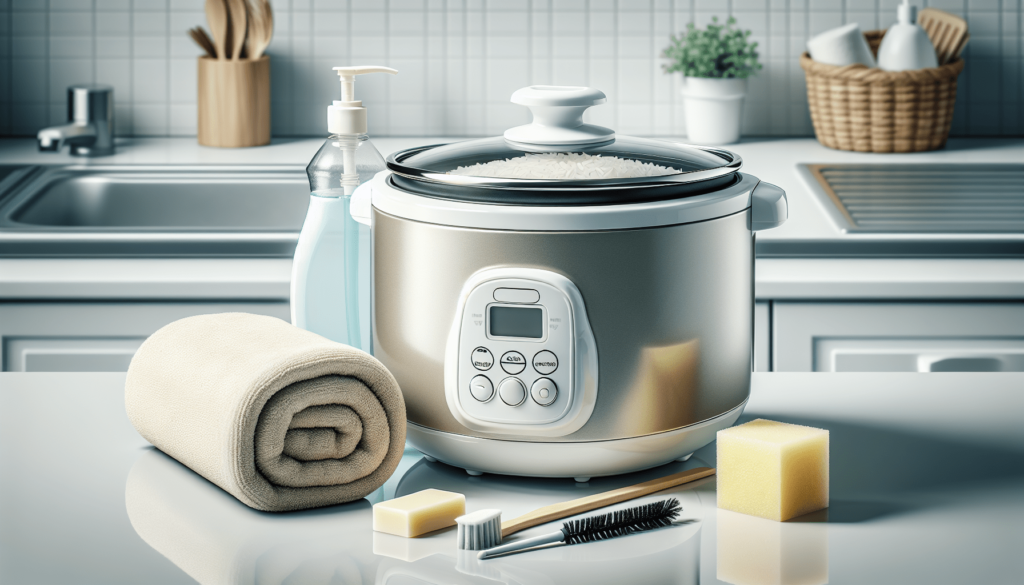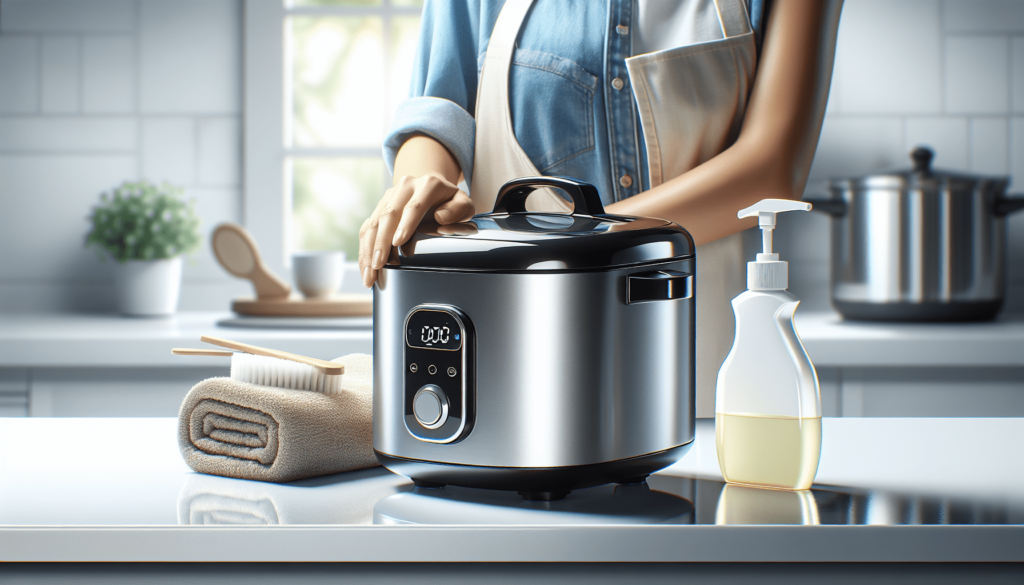
Maintaining the cleanliness and longevity of your compact rice cooker is essential to ensure its efficient performance and prolong its lifespan. In this article, you will discover simple yet effective tips and techniques on how to clean and maintain your compact rice cooker, enabling you to enjoy deliciously cooked rice for years to come. Whether you are a beginner or a seasoned cook, these easy-to-follow steps will guarantee that your rice cooker remains in top-notch condition, ready to serve up perfectly fluffy rice with every use.

Understanding the Importance of Regular Cleaning
Taking care of your compact rice cooker is essential to ensure its longevity and to maintain its optimal performance. Regular cleaning not only helps to keep your rice cooker in good working condition but also ensures the safety and hygiene of your food. By establishing a cleaning routine, preventing bacterial growth, and prolonging the lifespan of your rice cooker, you can enjoy delicious, perfectly cooked rice for years to come.
Establishing a cleaning routine
Setting a cleaning schedule for your rice cooker will help you stay on top of its maintenance. It is recommended to clean the rice cooker after every use to prevent any residue or buildup. Begin by unplugging the cooker and allowing it to cool down before cleaning. By incorporating this simple step into your post-cooking routine, you can maintain a clean and well-functioning rice cooker effortlessly.
Preventing bacterial growth
Bacterial growth can occur if your rice cooker is not cleaned regularly. The warm and moist environment inside the cooker creates the perfect breeding ground for bacteria. To prevent this, it is crucial to clean all parts of the rice cooker thoroughly. By doing so, you eliminate any potential foodborne illnesses and maintain the quality of your rice.
Prolonging the lifespan of the rice cooker
A well-maintained rice cooker can last for many years, providing you with perfectly cooked rice time and time again. Regular cleaning helps to prevent the buildup of mineral deposits and other residue, which can affect the performance of the cooker. By taking care of your rice cooker and following proper cleaning practices, you can extend its lifespan and ensure its reliability.
Knowing the Parts of Your Rice Cooker
To effectively clean your compact rice cooker, it is important to familiarize yourself with its different parts and functions. By understanding the purpose and function of each component, you can clean them efficiently and ensure thorough maintenance.
Identifying removable parts
Many compact rice cookers have removable parts that can be easily detached for cleaning. These typically include the cooking pot, inner lid, and steam vent. Make sure to identify these removable parts before you start cleaning, as they require special attention during the cleaning and drying process.
Familiarizing with non-removable elements
While some parts of your rice cooker can be easily removed, others are non-removable. These include the heating plate and the exterior body of the cooker. Familiarize yourself with these components to ensure you can clean them properly without damaging the cooker.
Function of each part
Understanding the function of each part will help you clean them effectively. The cooking pot is where the rice is cooked and needs to be cleaned thoroughly after each use. The inner lid helps to regulate the steam and should be cleaned regularly to prevent any buildup. The heating plate is responsible for cooking the rice evenly and should be wiped clean with a damp cloth. Lastly, the exterior body of the cooker requires gentle cleaning to maintain its appearance and prevent any damage.
Gathering Cleaning Materials
Before you start cleaning your compact rice cooker, it is important to gather the necessary cleaning materials. Using the right cleaning products and tools will ensure that you clean your rice cooker effectively without causing any damage.
Choosing non-abrasive cleaners
When cleaning your rice cooker, it is essential to choose non-abrasive cleaners. Harsh chemicals or abrasive cleansers can damage the surfaces of your cooker. Opt for mild, non-abrasive cleaning solutions specifically designed for kitchen appliances. These cleaners will effectively remove any residue or buildup without causing any harm.
Opting for mild soaps
Mild soaps or dishwashing liquids are ideal for cleaning the removable parts of your rice cooker. These gentle soaps will help remove any grease or residue from the cooking pot and inner lid without leaving behind any harmful chemicals. Make sure to rinse the parts thoroughly after cleaning to ensure no soap residue remains.
Using soft scrubbing tools
When it comes to scrubbing your rice cooker, it is important to use soft tools to prevent any scratches or damage. Avoid using metal scrubbers or abrasive brushes, as they can scratch the surfaces of your cooker. Instead, opt for soft sponges or brushes with nylon bristles to gently scrub away any stubborn residue or stains.

Cleaning the Cooking Pot
The cooking pot is an essential component of your rice cooker and requires regular cleaning to ensure the quality and taste of your rice. Follow these steps to clean the cooking pot effectively:
Rinsing with warm water
After removing the cooking pot from the rice cooker, rinse it thoroughly with warm water. This will help remove any loose particles or residue. Make sure to rinse the pot both inside and out, paying extra attention to the bottom where any food particles may have collected.
Avoiding metal scrubbers
When it comes to cleaning the cooking pot, avoid using metal scrubbers as they can damage the non-stick coating. Instead, use a soft sponge or nylon-bristle brush to gently scrub away any remaining residue. This will help maintain the integrity of the non-stick surface, ensuring even cooking and easy release of the rice.
Drying thoroughly before reassembling
Once you have cleaned the cooking pot, it is important to dry it thoroughly before reassembling your rice cooker. Use a clean, dry cloth to remove any excess water and allow the pot to air dry completely. Make sure there is no moisture left, as it can lead to bacterial growth or damage the rice cooker when it is in use.
Refreshing the Inner Lid
The inner lid of your rice cooker plays a crucial role in regulating the steam and maintaining the perfect cooking conditions. To ensure its effectiveness and cleanliness, follow these steps to refresh the inner lid:
Detaching and rinsing properly
Carefully detach the inner lid from the rice cooker and rinse it properly. Use warm water to remove any food particles or residue that may have accumulated. Pay attention to the edges and corners of the lid, as these areas can harbor bacteria and contaminants.
Cleaning with a damp cloth
After rinsing, gently wipe the inner lid with a damp cloth to remove any remaining residue or stains. Ensure that you clean all surfaces of the lid, including the hinges and latch. This will help maintain the functionality of the lid and prevent any interference with the cooking process.
Monitoring for wear and tear
While cleaning the inner lid, take the opportunity to inspect it for any signs of wear and tear. Check the hinges and latch for any loose or damaged parts. If you notice any issues, it may be necessary to replace the inner lid to ensure proper functioning and safety.
Handling the Heating Plate
The heating plate is a non-removable part of your rice cooker that requires special care during cleaning. Follow these steps to handle the heating plate safely and effectively:
Observing caution (since it’s non-removable)
Due to its non-removable nature, the heating plate must be approached with caution during the cleaning process. Make sure the rice cooker is unplugged and has cooled down before attempting to clean the heating plate. This will prevent any accidents or injuries.
Cleaning with a soft, damp cloth
To clean the heating plate, use a soft, damp cloth to wipe away any residue or stains. Avoid using abrasive cleaners or scrubbing tools, as they can damage the surface of the heating plate. Gently wipe the heating plate, ensuring that it is free from any food particles or buildup.
Ensuring it’s dry before use
Before using the rice cooker again, ensure that the heating plate is completely dry. Any moisture left on the heating plate can cause electrical issues or damage the cooker over time. Use a clean, dry cloth to remove any excess water and allow the heating plate to air dry before reassembling the rice cooker.
Maintaining the Exterior
Keeping the exterior of your rice cooker clean not only enhances its appearance but also prolongs its lifespan. Follow these steps to maintain the exterior of your rice cooker:
Wiping stains immediately
If you notice any stains or spills on the exterior of your rice cooker, it is important to wipe them immediately. Use a soft, dry cloth to gently remove any food particles or residue. Promptly addressing any spills will prevent them from drying and potentially causing stains or damage to the exterior surface.
Using a soft, dry cloth
When cleaning the exterior of your rice cooker, always use a soft, dry cloth. Avoid using abrasive cleaners or harsh chemicals, as they can damage the finish of your cooker. Gently wipe the exterior, paying attention to intricate details or buttons, to remove any dust or residue.
Avoiding exposure to sunlight or heat sources
To maintain the quality and appearance of the exterior, it is important to avoid exposing your rice cooker to direct sunlight or heat sources. Prolonged exposure to these elements can cause discoloration or damage to the exterior surface. Instead, store your rice cooker in a cool and dry place when not in use.
Periodic Maintenance Checks
In addition to regular cleaning, it is important to perform periodic maintenance checks to ensure the proper functioning and safety of your rice cooker. Follow these steps to perform effective maintenance checks:
Checking for damaged cords or plugs
Regularly inspect the power cord and plugs for any signs of damage or wear. Look for frayed wires, exposed metal, or broken plugs. If you notice any issues, it is important to replace the cord or plug immediately to prevent electrical hazards.
Looking for dents or deformities
Inspect the exterior body of your rice cooker for any dents, deformities, or cracks. These can affect the performance of the cooker and compromise its safety. If you notice any significant damage, it may be necessary to replace your rice cooker.
Ensuring proper functioning of switches and buttons
Test the switches and buttons of your rice cooker to ensure they are functioning properly. This includes the power switch, cooking functions, and any additional settings. If you encounter any issues with the switches or buttons, consult the user manual or contact the manufacturer for assistance.
Troubleshooting Common Problems
Despite regular cleaning and maintenance, you may encounter common problems with your rice cooker. Understanding the causes and solutions to these issues can help you troubleshoot effectively:
Reasons for uncooked or overcooked rice
If your rice is consistently coming out uncooked or overcooked, it may be due to incorrect water-to-rice ratio or cooking time. Refer to the user manual for the recommended measurements and cooking times. Adjust these factors accordingly to ensure perfectly cooked rice.
Causes of the cooker not switching on
If your rice cooker is not switching on, check the power cord and plug for any damage or loose connections. Make sure the cooker is properly plugged into a working electrical outlet. If the issue persists, it may require professional repair or replacement.
Steps to fix a cooker that keeps tripping the power
If your rice cooker keeps tripping the power, it could be caused by a faulty power cord or a problem with the electrical circuit. First, try using a different outlet to ensure there is no issue with the circuit. If the problem persists, consult a professional appliance repair service for further assistance.
When to Get Professional Help
While regular cleaning and maintenance can keep your rice cooker in good condition, there may be instances where professional help is required:
Understanding the limitations of DIY maintenance
While you may be able to perform regular cleaning and maintenance yourself, there are certain limitations to DIY maintenance. If you encounter complex mechanical issues or electrical problems, it is best to seek professional help to avoid further damage or safety hazards.
Recognizing complex mechanical issues
If you notice any unusual noises, leaks, or malfunctions with your rice cooker, it is important to seek professional assistance. These signs may indicate complex mechanical issues that require the expertise of a trained technician to diagnose and repair.
Choosing a trusted appliance repair service
When seeking professional help for your rice cooker, choose a trusted appliance repair service with experience working on rice cookers. Research reviews and ask for recommendations to ensure you choose a service that specializes in repairing rice cookers and can provide reliable and efficient assistance.
By understanding the importance of regular cleaning and maintenance, knowing the various parts of your rice cooker, gathering the right cleaning materials, and following the proper cleaning procedures, you can ensure the longevity and optimal performance of your compact rice cooker. With a clean and well-maintained rice cooker, you can continue to enjoy perfectly cooked rice with ease and peace of mind.